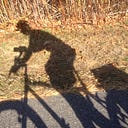RIP Sam Huff, the Coal Miner’s Son Who Stopped Jim Brown. (Rats.)
When I was a kid discovering sports, Sam Huff was one of the first football players who seemed to have both great skill and a real identity under that uniform and helmet.

The only downside is that a big part of the identity was keeping my team, the Cleveland Browns, from ever beating his team, the New York Giants.
Sam Huff died Saturday at the age of 87, sadly after several years of dementia. You always wonder with ex-players if getting hit on the head so many times over a long career was a factor, but in Sam Huff’s case he almost certainly wouldn’t have taken back a single helmet-to-chest collision. As a broadcaster later in life he criticized NFL rules designed to cut down on direct helmet impact, saying they were softening a “man’s game.”
That was not my focus in the late 1950s when Huff, as the middle linebacker for the Giants, was given the task of personally stopping Jim Brown, the Cleveland running back who was arguably — well, not “arguably” to me — the greatest running back ever.

Huff was good at that. He didn’t stop Brown on every play, just enough to short-circuit the Cleveland offense way too often for my enjoyment.
Specifically, I note the game of Dec. 14, 1958. The Browns came in with a 9–2 record, the Giants 8–3, so the Browns only needed a tie to win the Eastern Conference and move to the championship game.
On the first play from scrimmage, Brown broke straight up the middle and went 65 yards for a touchdown. I was very happy.
I was also about to learn why it is never a good idea to be very happy in the early stages of a sporting event. Brown went on to have a strong game, running for 140 yards. But the Giants, led by Huff, stopped him when they had to. They stopped him short of a touchdown in the second quarter and the Browns settled for a field goal, going up 10–3.
Dec. 14, 1958, by then had turned into a miserable day at Yankee Stadium, where the game was played. It was cold and it started to snow. Like, really snow. After the Giants scored another touchdown, both teams had trouble doing much of anything — which was okay, since the Browns only needed that 10–10 tie.
Then, as time was expiring, the Giants’s Pat Summerall kicked a 49-yard field goal. It looked like 75 yards. It looked like he couldn’t even see the goal posts through the snow. But there it went — “49 yards and one foot,” in sportswriting lore.
A week later, the Giants and Browns held a playoff game. This time the Giants, led by Huff, shut down Brown completely, allowing him only eight yards. The Giants won, 10–0, which qualified them to play the Baltimore Colts in the 1958 championship game.
The Colts won that one, 23–17, with Alan Ameche scoring the winning touchdown on a play Huff said haunted him for the rest of his career. Huff shifted left, Ameche went right.
This defeat was more crushing for Giants fans than the Browns’s defeat had been for me. But that game is also widely credited with putting pro football on the sports-fan and television map, which over the years has worked out well for all concerned.
Huff, already the best middle linebacker in the game, went on to be the best or one of the best for another decade. He intercepted 30 passes and played a central role in defining the middle linebacker as the quarterback of the defense.
There were other elite middle linebackers at the time — Joe Schmidt of the Lions, Chuck Bednarik of the Eagles, Ray Nitschke of the Packers — but at the very least they were no better than Huff, who could seemingly blanket the whole field.
Jim Brown often joked years later that “Huff became famous for tackling me,” and that’s not entirely untrue, because it was not something everyone could do. “You grab hold,” Huff said, “then you hang on and wait for help.”
Middle linebacker has become less of a focal point with today’s sophisticated defenses, though the average fan still probably remembers more middle linebackers than any other defensive player: Dick Butkus of the Bears, Mike Curtis of the Colts, Ray Lewis of the Ravens and Huff’s latter-day successor with the Giants, Lawrence Taylor, who made his own case for being the best ever.
Huff was traded to the Redskins in 1964, for which he said he never forgave Giants’ coach Allie Sherman, and he retired in 1969. He worked for years as a sports marketer at Marriott and a radio color commentator, first with the Giants and then the Redskins. He retired in 2013, by which time he was in both the college and pro football halls of fame.

Not bad for a kid who grew up during the Depression in a West Virginia coal mining camp, in a house with no running water. A kid who almost left Giants’s camp as a rookie because the Giants couldn’t find a position for him, but was talked back by Vince Lombardi. By 1960 he was being featured in the CBS special “The Violent World of Sam Huff,” which had him wired for sound in a game against the Bears, and he had become the first pro football player on the cover of Time magazine.
And oh, by the way, his salary with the Giants, by the end of his time there, had soared to $19,000 a season. For that, he got to tackle Jim Brown.
At the age of 9, I wouldn’t have admired him any less if he’d just sprained his ankle before they played Cleveland.
